User:Tigraan/Grass for non-biologists

Grass is the collective name for various plants surfacing from the soil in natural or artificial grounds.
Natural occurrence[edit]
Artificial occurence[edit]
Lawn and ornamental use[edit]

Lawns are made of grasses derived from grazed grasslands in Europe[citation needed] which are maintained by human intervention for esthetic purposes. They also provide an important means of erosion control (e.g., along roadsides), especially on sloping land.[citation needed] Grass lawns are an important covering of playing surfaces in many sports, including football (soccer), American football, tennis, golf, cricket, softball and baseball.
Ornamental grasses, such as perennial bunch grasses, are used in many styles of garden design for their foliage, inflorescences, seed heads. They are often used in natural landscaping, xeriscaping and slope and beach stabilization in contemporary landscaping, wildlife gardening, and native plant gardening.[citation needed] They are used as screens and hedges.[1]
Sports turf[edit]
Grass playing fields, courses and pitches are the traditional playing surfaces for many sports, including American football, association football, baseball, cricket, golf, and rugby. Grass surfaces are also sometimes used for horse racing and tennis. Type of maintenance and species of grass used may be important factors for some sports, less critical for others. In some sports facilities, including indoor domes and other places where maintenance of a grass field would be difficult, grass may be replaced with artificial turf, a synthetic grass-like substitute.[2]
Cricket[edit]

In cricket, the pitch is the strip of carefully mowed and rolled grass where the bowler bowls. In the days leading up to the match it is repeatedly mowed and rolled to produce a very hard, flat surface for the ball to bounce off.[3]
Golf[edit]
Grass on golf courses is kept in three distinct conditions: that of the rough, the fairway, and the putting green. Grass on the fairway is mown short and even, allowing the player to strike the ball cleanly. Playing from the rough is a disadvantage because the long grass may affect the flight of the ball. Grass on the putting green is the shortest and most even, ideally allowing the ball to roll smoothly over the surface. An entire industry revolves around the development and marketing of turf grass varieties.[4]
Tennis[edit]
In tennis, grass is grown on very hard-packed soil, and the bounce of a tennis ball may vary depending on the grass's health, how recently it has been mowed, and the wear and tear of recent play.[citation needed] The surface is softer than hard courts and clay (other tennis surfaces), so the ball bounces lower, and players must reach the ball faster resulting in a different style of play which may suit some players more than others.[citation needed] Among the world's most prestigious court for grass tennis is Centre Court at Wimbledon, London which hosts the final of the annual Wimbledon Championships in England, one of the four Grand Slam tournaments.
- ^ Holmes, Roger (1997). Taylor's Guide to Ornamental Grasses. Houghton Mifflin Harcourt. ISBN 978-0-395-79761-7.
- ^ "Pats sign Testaverde; Gillette Stadium's grass field replaced with Field Turf - USATODAY.com". usatoday30.usatoday.com. Retrieved 2019-12-10.
- ^ Tainton, Neil; van Deventer, Pietr. "Cricket pitches Principles and practice of pitch preparation". cricinfo. Archived from the original on 2017-06-09.
- ^ Stier, John C.; Horgan, Brian P.; Bonos, Stacy A. (2020-01-22). Turfgrass: Biology, Use, and Management. John Wiley & Sons. ISBN 978-0-89118-613-7.
